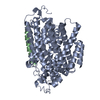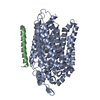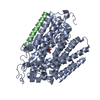[English] 日本語
 Yorodumi
Yorodumi- EMDB-33964: Structure of human SGLT2-MAP17 complex in the apo state in the in... -
+ Open data
Open data
- Basic information
Basic information
| Entry |  | ||||||||||||
|---|---|---|---|---|---|---|---|---|---|---|---|---|---|
| Title | Structure of human SGLT2-MAP17 complex in the apo state in the inward-facing conformation | ||||||||||||
 Map data Map data | masked and sharpened map for refinement | ||||||||||||
 Sample Sample |
| ||||||||||||
 Keywords Keywords |  glucose transporter / glucose transporter /  SGLT / sodium glucose transporter / SGLT / sodium glucose transporter /  membrane protein / membrane protein /  PROTEIN TRANSPORT PROTEIN TRANSPORT | ||||||||||||
| Function / homology |  Function and homology information Function and homology informationlow-affinity glucose:sodium symporter activity / Defective SLC5A2 causes renal glucosuria (GLYS1) / alpha-glucoside transport / glucose:sodium symporter activity / alpha-glucoside transmembrane transporter activity / hexose transmembrane transport / D-glucose transmembrane transporter activity / Cellular hexose transport /  renal glucose absorption / glucose import across plasma membrane ...low-affinity glucose:sodium symporter activity / Defective SLC5A2 causes renal glucosuria (GLYS1) / alpha-glucoside transport / glucose:sodium symporter activity / alpha-glucoside transmembrane transporter activity / hexose transmembrane transport / D-glucose transmembrane transporter activity / Cellular hexose transport / renal glucose absorption / glucose import across plasma membrane ...low-affinity glucose:sodium symporter activity / Defective SLC5A2 causes renal glucosuria (GLYS1) / alpha-glucoside transport / glucose:sodium symporter activity / alpha-glucoside transmembrane transporter activity / hexose transmembrane transport / D-glucose transmembrane transporter activity / Cellular hexose transport /  renal glucose absorption / glucose import across plasma membrane / sodium ion import across plasma membrane / sodium ion transport / carbohydrate metabolic process / apical plasma membrane / extracellular exosome / renal glucose absorption / glucose import across plasma membrane / sodium ion import across plasma membrane / sodium ion transport / carbohydrate metabolic process / apical plasma membrane / extracellular exosome /  membrane / membrane /  plasma membrane plasma membraneSimilarity search - Function | ||||||||||||
| Biological species |   Homo sapiens (human) Homo sapiens (human) | ||||||||||||
| Method |  single particle reconstruction / single particle reconstruction /  cryo EM / Resolution: 3.48 Å cryo EM / Resolution: 3.48 Å | ||||||||||||
 Authors Authors | Chen L / Niu Y | ||||||||||||
| Funding support |  China, 3 items China, 3 items
| ||||||||||||
 Citation Citation |  Journal: Nat Commun / Year: 2023 Journal: Nat Commun / Year: 2023Title: Structures of human SGLT in the occluded state reveal conformational changes during sugar transport. Authors: Wenhao Cui / Yange Niu / Zejian Sun / Rui Liu / Lei Chen /  Abstract: Sodium-Glucose Cotransporters (SGLT) mediate the uphill uptake of extracellular sugars and play fundamental roles in sugar metabolism. Although their structures in inward-open and outward-open ...Sodium-Glucose Cotransporters (SGLT) mediate the uphill uptake of extracellular sugars and play fundamental roles in sugar metabolism. Although their structures in inward-open and outward-open conformations are emerging from structural studies, the trajectory of how SGLTs transit from the outward-facing to the inward-facing conformation remains unknown. Here, we present the cryo-EM structures of human SGLT1 and SGLT2 in the substrate-bound state. Both structures show an occluded conformation, with not only the extracellular gate but also the intracellular gate tightly sealed. The sugar substrate are caged inside a cavity surrounded by TM1, TM2, TM3, TM6, TM7, and TM10. Further structural analysis reveals the conformational changes associated with the binding and release of substrates. These structures fill a gap in our understanding of the structural mechanisms of SGLT transporters. | ||||||||||||
| History |
|
- Structure visualization
Structure visualization
| Supplemental images |
|---|
- Downloads & links
Downloads & links
-EMDB archive
| Map data |  emd_33964.map.gz emd_33964.map.gz | 3.2 MB |  EMDB map data format EMDB map data format | |
|---|---|---|---|---|
| Header (meta data) |  emd-33964-v30.xml emd-33964-v30.xml emd-33964.xml emd-33964.xml | 19.6 KB 19.6 KB | Display Display |  EMDB header EMDB header |
| FSC (resolution estimation) |  emd_33964_fsc.xml emd_33964_fsc.xml | 9.3 KB | Display |  FSC data file FSC data file |
| Images |  emd_33964.png emd_33964.png | 55.3 KB | ||
| Masks |  emd_33964_msk_1.map emd_33964_msk_1.map | 83.7 MB |  Mask map Mask map | |
| Filedesc metadata |  emd-33964.cif.gz emd-33964.cif.gz | 5.7 KB | ||
| Others |  emd_33964_additional_1.map.gz emd_33964_additional_1.map.gz emd_33964_additional_2.map.gz emd_33964_additional_2.map.gz emd_33964_half_map_1.map.gz emd_33964_half_map_1.map.gz emd_33964_half_map_2.map.gz emd_33964_half_map_2.map.gz | 78.9 MB 41.1 MB 77.8 MB 77.8 MB | ||
| Archive directory |  http://ftp.pdbj.org/pub/emdb/structures/EMD-33964 http://ftp.pdbj.org/pub/emdb/structures/EMD-33964 ftp://ftp.pdbj.org/pub/emdb/structures/EMD-33964 ftp://ftp.pdbj.org/pub/emdb/structures/EMD-33964 | HTTPS FTP |
-Related structure data
| Related structure data |  7ynkMC  7yniC  7ynjC M: atomic model generated by this map C: citing same article ( |
|---|---|
| Similar structure data | Similarity search - Function & homology  F&H Search F&H Search |
- Links
Links
| EMDB pages |  EMDB (EBI/PDBe) / EMDB (EBI/PDBe) /  EMDataResource EMDataResource |
|---|---|
| Related items in Molecule of the Month |
- Map
Map
| File |  Download / File: emd_33964.map.gz / Format: CCP4 / Size: 6.6 MB / Type: IMAGE STORED AS FLOATING POINT NUMBER (4 BYTES) Download / File: emd_33964.map.gz / Format: CCP4 / Size: 6.6 MB / Type: IMAGE STORED AS FLOATING POINT NUMBER (4 BYTES) | ||||||||||||||||||||
|---|---|---|---|---|---|---|---|---|---|---|---|---|---|---|---|---|---|---|---|---|---|
| Annotation | masked and sharpened map for refinement | ||||||||||||||||||||
| Voxel size | X=Y=Z: 0.821 Å | ||||||||||||||||||||
| Density |
| ||||||||||||||||||||
| Symmetry | Space group: 1 | ||||||||||||||||||||
| Details | EMDB XML:
|
-Supplemental data
-Mask #1
| File |  emd_33964_msk_1.map emd_33964_msk_1.map | ||||||||||||
|---|---|---|---|---|---|---|---|---|---|---|---|---|---|
| Projections & Slices |
| ||||||||||||
| Density Histograms |
-Additional map: sharpened map
| File | emd_33964_additional_1.map | ||||||||||||
|---|---|---|---|---|---|---|---|---|---|---|---|---|---|
| Annotation | sharpened map | ||||||||||||
| Projections & Slices |
| ||||||||||||
| Density Histograms |
-Additional map: #1
| File | emd_33964_additional_2.map | ||||||||||||
|---|---|---|---|---|---|---|---|---|---|---|---|---|---|
| Projections & Slices |
| ||||||||||||
| Density Histograms |
-Half map: #1
| File | emd_33964_half_map_1.map | ||||||||||||
|---|---|---|---|---|---|---|---|---|---|---|---|---|---|
| Projections & Slices |
| ||||||||||||
| Density Histograms |
-Half map: #2
| File | emd_33964_half_map_2.map | ||||||||||||
|---|---|---|---|---|---|---|---|---|---|---|---|---|---|
| Projections & Slices |
| ||||||||||||
| Density Histograms |
- Sample components
Sample components
-Entire : human SGLT2-MAP17 complex
| Entire | Name: human SGLT2-MAP17 complex |
|---|---|
| Components |
|
-Supramolecule #1: human SGLT2-MAP17 complex
| Supramolecule | Name: human SGLT2-MAP17 complex / type: complex / ID: 1 / Parent: 0 / Macromolecule list: all |
|---|---|
| Source (natural) | Organism:   Homo sapiens (human) Homo sapiens (human) |
-Macromolecule #1: Sodium/glucose cotransporter 2
| Macromolecule | Name: Sodium/glucose cotransporter 2 / type: protein_or_peptide / ID: 1 / Number of copies: 1 / Enantiomer: LEVO |
|---|---|
| Source (natural) | Organism:   Homo sapiens (human) Homo sapiens (human) |
| Molecular weight | Theoretical: 72.949414 KDa |
| Recombinant expression | Organism:   Homo sapiens (human) Homo sapiens (human) |
| Sequence | String: MEEHTEAGSA PEMGAQKALI DNPADILVIA AYFLLVIGVG LWSMCRTNRG TVGGYFLAGR SMVWWPVGAS LFASNIGSGH FVGLAGTGA ASGLAVAGFE WNALFVVLLL GWLFAPVYLT AGVITMPQYL RKRFGGRRIR LYLSVLSLFL YIFTKISVDM F SGAVFIQQ ...String: MEEHTEAGSA PEMGAQKALI DNPADILVIA AYFLLVIGVG LWSMCRTNRG TVGGYFLAGR SMVWWPVGAS LFASNIGSGH FVGLAGTGA ASGLAVAGFE WNALFVVLLL GWLFAPVYLT AGVITMPQYL RKRFGGRRIR LYLSVLSLFL YIFTKISVDM F SGAVFIQQ ALGWNIYASV IALLGITMIY TVTGGLAALM YTDTVQTFVI LGGACILMGY AFHEVGGYSG LFDKYLGAAT SL TVSEDPA VGNISSFCYR PRPDSYHLLR HPVTGDLPWP ALLLGLTIVS GWYWCSDQVI VQRCLAGKSL THIKAGCILC GYL KLTPMF LMVMPGMISR ILYPDEVACV VPEVCRRVCG TEVGCSNIAY PRLVVKLMPN GLRGLMLAVM LAALMSSLAS IFNS SSTLF TMDIYTRLRP RAGDRELLLV GRLWVVFIVV VSVAWLPVVQ AAQGGQLFDY IQAVSSYLAP PVSAVFVLAL FVPRV NEQG AFWGLIGGLL MGLARLIPEF SFGSGSCVQP SACPAFLCGV HYLYFAIVLF FCSGLLTLTV SLCTAPIPRK HLHRLV FSL RHSKEEREDL DADEQQGSSL PVQNGCPESA MEMNEPQAPA PSLFRQCLLW FCGMSRGGVG SPPPLTQEEA AAAARRL ED ISEDPSWARV VNLNALLMMA VAVFLWGFYA UniProtKB: Sodium/glucose cotransporter 2 |
-Macromolecule #2: PDZK1-interacting protein 1
| Macromolecule | Name: PDZK1-interacting protein 1 / type: protein_or_peptide / ID: 2 / Number of copies: 1 / Enantiomer: LEVO |
|---|---|
| Source (natural) | Organism:   Homo sapiens (human) Homo sapiens (human) |
| Molecular weight | Theoretical: 12.235 KDa |
| Recombinant expression | Organism:   Homo sapiens (human) Homo sapiens (human) |
| Sequence | String: MSALSLLILG LLTAVPPASC QQGLGNLQPW MQGLIAVAVF LVLVAIAFAV NHFWCQEEPE PAHMILTVGN KADGVLVGTD GRYSSMAAS FRSSEHENAY ENVPEEEGKV RSTPM UniProtKB: PDZK1-interacting protein 1 |
-Experimental details
-Structure determination
| Method |  cryo EM cryo EM |
|---|---|
 Processing Processing |  single particle reconstruction single particle reconstruction |
| Aggregation state | particle |
- Sample preparation
Sample preparation
| Buffer | pH: 7.5 |
|---|---|
| Vitrification | Cryogen name: ETHANE |
- Electron microscopy
Electron microscopy
| Microscope | FEI TITAN KRIOS |
|---|---|
| Electron beam | Acceleration voltage: 300 kV / Electron source:  FIELD EMISSION GUN FIELD EMISSION GUN |
| Electron optics | Illumination mode: SPOT SCAN / Imaging mode: BRIGHT FIELD Bright-field microscopy / Nominal defocus max: 1.8 µm / Nominal defocus min: 1.5 µm Bright-field microscopy / Nominal defocus max: 1.8 µm / Nominal defocus min: 1.5 µm |
| Image recording | Film or detector model: GATAN K2 SUMMIT (4k x 4k) / Average electron dose: 50.0 e/Å2 |
| Experimental equipment |  Model: Titan Krios / Image courtesy: FEI Company |
 Movie
Movie Controller
Controller







 Z
Z Y
Y X
X










































